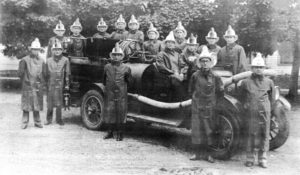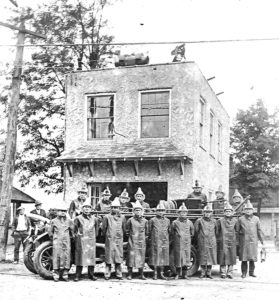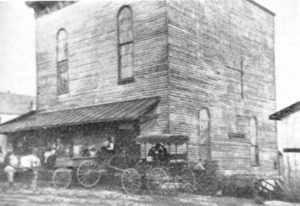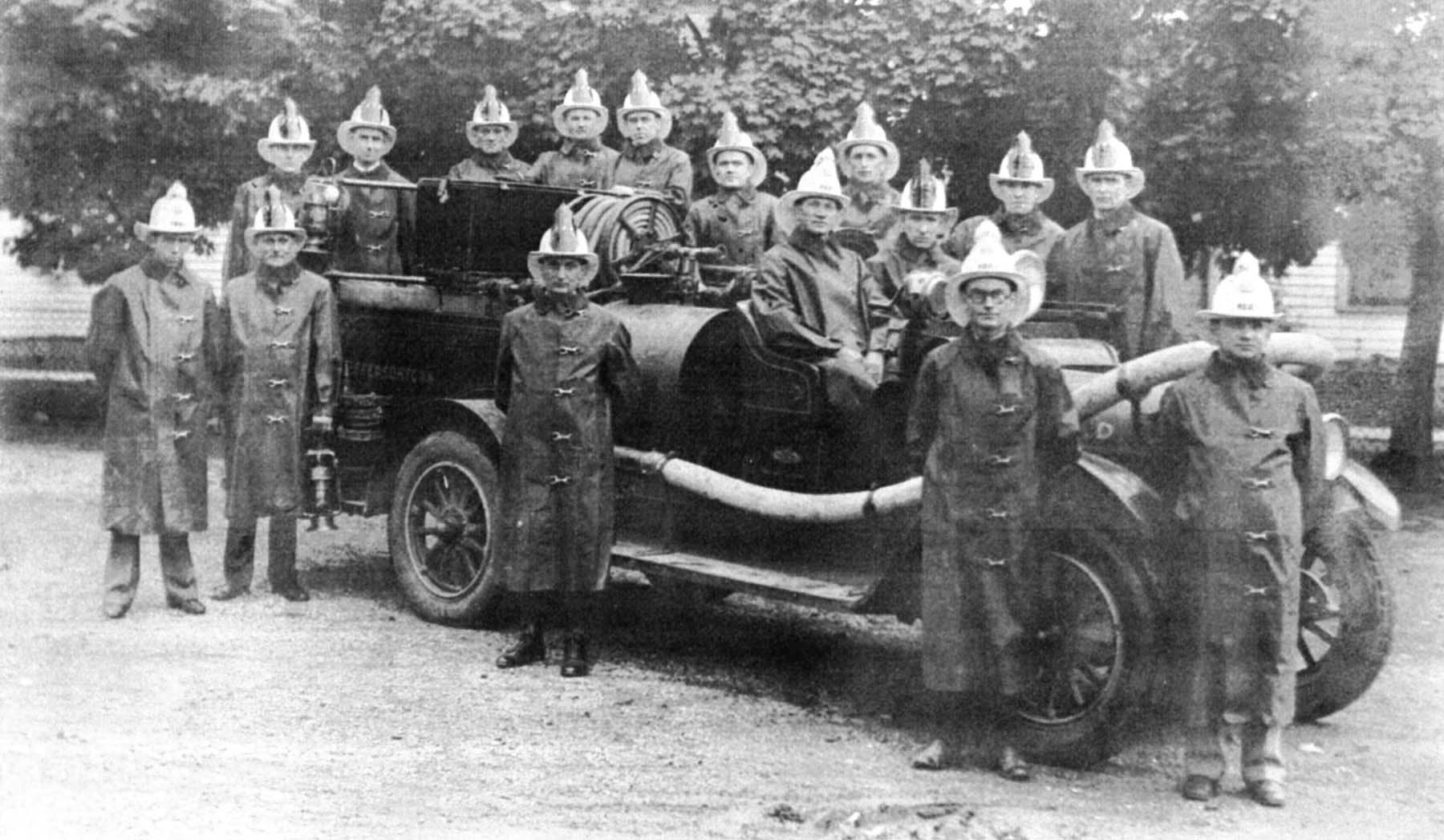Exploring the Founding of the Jeffersontown Fire Department
Writer / Beth Wilder
Photography Provided
No single article can even begin to do justice to the selfless individuals who have served as firefighters throughout the decades. Jeffersontown is no exception when it comes to brave men and women who have offered their services, often at great risk to their own lives, to make certain that others are kept safe. While Jeffersontown undeniably has one of the best fire departments there is today, this article will actually focus on the origins of that department.
When one thinks of early settlements in America, certain images come to mind – log cabins, spring-fed wells, fireplaces for cooking food and warming the house, candles and oil lamps to light the dark of night. These are nostalgic images, but combined at the wrong time, they could prove to be a recipe for disaster. Back then, it did not take much to spark a fire, but it took a great deal of effort and cooperation to put one out.
The earliest means of fighting fires was a simple bucket of water kept in the home for just such an emergency. Since most colonial settlers tended to live miles apart from one another, each homeowner was pretty much left to his own devices where fighting fires was concerned.
Those who lived in towns, however, had a little more hope of gaining assistance in putting out fires. Of course, being in close proximity to so many other wooden buildings, they also faced a greater risk of having their own places burned down if a fire got the chance to spread. Still, the closeness of neighbors allowed for what was termed a bucket brigade – that is, everyone grabbed their buckets and formed a line to the nearest water source, then they simply filled the buckets and passed them down the row, poured them on the flames, then sent them back down the line to be refilled. Up through the 1920s, this was the primary means by which Jeffersontown residents fought fires on the town square. Their main source of water was the Old Mill Pond, behind the Jeffersontown Roller Mill, owned by David A. Davis (ironically, the mill itself burned down in 1910). The property at 10404 Watterson Trail was later the site of E.G. Hewitt’s hardware shop, and is currently occupied by Neutz Brothers Cars, Trucks and Vans.
The earliest recorded mention of a need in Jeffersontown for more than merely a bucket brigade was in the July 1910 Jeffersonian newspaper. Rufus Smith addressed the Jeffersontown Commercial Club (which was akin to an early chamber of commerce), suggesting they should procure a fire engine for the town, so a committee was formed to investigate the cost of a chemical engine and other ways of extinguishing fires. The men also set about soliciting subscriptions to pay for an engine.
By the August meeting of the Commercial Club, it was noted that a fire engine seemed to be a certainty for Jeffersontown. The cost of a gasoline fire engine was estimated at $1,200, and the townspeople had already subscribed several hundred dollars at that point, indicating their eagerness to find a better means of fire protection for the town.
One major proponent for fire protection was Frank Fanelli, who owned a store at the corner of Watterson Trail and Taylorsville Road, where King Southern Bank now stands. The store caught fire early one morning in February of 1911, but the flames were quickly doused by the fire extinguisher Fanelli had just purchased the day before. A disaster was averted, and the Jeffersonian newspaper noted that “the damage will not exceed $25. A stiff breeze was blowing, and had the fire gained a headway the building and other surrounding property would have been consumed by the flames, entailing a loss of probably $25,000 or more.”
After that, many Jeffersontown businessmen purchased fire extinguishers from Fanelli at cost ($7.00). Fanelli strongly encouraged all the townspeople to buy extinguishers, not because he sold them, but because they were invaluable to have in the event of a fire.
 Residents of Jeffersontown were well aware of the dangers that even a small fire could pose to the town, if not their own property. By this time, many people had taken out insurance policies on their homes and businesses, but they really wanted even more protection from fire, so they did their part to contribute in any way they could. In June of 1912, the Jeffersontown Commercial Club purchased two LaFrance chemical fire engines, and in July they elected Frank Fanelli as chief of the volunteer fire department, with P.P. Litterer, Walter Jones, Roland Tyler and Barto Roemele as assistants.
Residents of Jeffersontown were well aware of the dangers that even a small fire could pose to the town, if not their own property. By this time, many people had taken out insurance policies on their homes and businesses, but they really wanted even more protection from fire, so they did their part to contribute in any way they could. In June of 1912, the Jeffersontown Commercial Club purchased two LaFrance chemical fire engines, and in July they elected Frank Fanelli as chief of the volunteer fire department, with P.P. Litterer, Walter Jones, Roland Tyler and Barto Roemele as assistants.
Each of the new fire engines held 45 gallons of extinguishing fluid, which was a mix of sulfuric acid and bicarbonate of soda. One gallon of fluid was equal to 30 gallons of water. Buckets of water were still an important part of fighting fires, and drills were organized by the volunteers to make sure the bucket brigades worked in concert with the new chemical engines, which had to be loaded atop wagons furnished by Wigginton & Sweeney.
A test run of the new fire equipment was held for all the town to see. An old house near the town square was set ablaze, and once the alarm was given, the Jeffersontown Fire Department rushed to the scene. They arrived so quickly, the chief gave orders to wait until the fire started spreading. Once the blaze took over, the firemen set to work and the fire was out within five minutes.
As wonderful as that sounds, the test run was made on a house close to the town square, where the fire apparatus was stored. A few months later, an actual fire gave a better idea of what the fire department was up against in the rural area it served. A headline in the Jeffersonian on December 19, 1912, read, “BARN BURNS – Outbuildings of W.S. Nicholson on Taylorsville Road Goes Up in Smoke.” The headline says it all, but the rest of the article mentions some of the problems the firemen had to deal with. After the alarm for the fire was given, it took half an hour for Fanelli to load the two fire engines onto a wagon and travel the two miles to Nicholson’s place. By the time the firefighters arrived, the burning barn was nearly destroyed. Fortunately for Nicholson, however, the firemen were able to prevent his residence from being damaged.
Still, the new department was incredibly advantageous to Jeffersontown, and it managed to grow quite well in the ensuing years. The town did suffer a couple of major fires in 1921 and 1925, after which it was ordered that anything built on the town square must be constructed of something more fire-resistant than wood frames. Dr. J.R. Shacklette’s home, which still stands in front of Neutz and Tudor Automotive Specialists on Watterson Trail, was the first local building to be constructed of terra-cotta tile. In 1926 a municipal building was erected at the corner of Taylorsville Road and Watterson Trail (near Karem’s Bait & Beverage) to house the firetrucks and city government offices. 
As noted earlier, there is far more that could be said about Jeffersontown’s excellent fire department, but hopefully this article has given you an idea of how it came to be in the first place. Thanks to all the men and women who have given so selflessly and been a part of our fire department through the years, and those who continue to make our town’s safety a priority.






